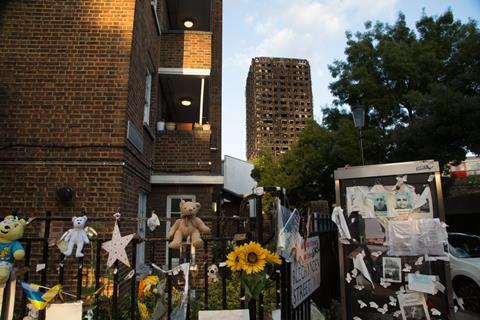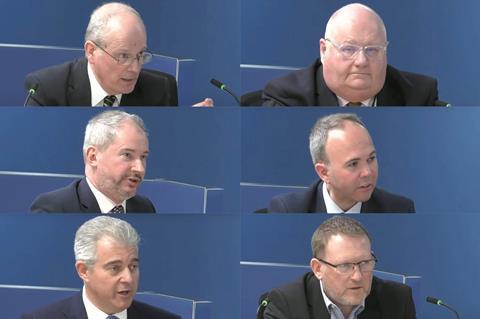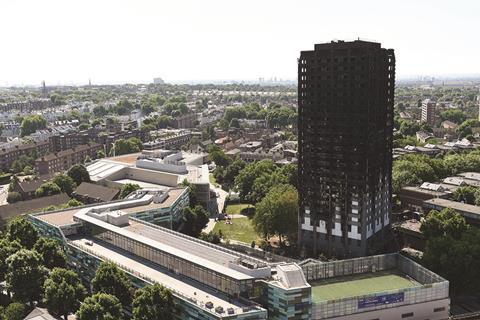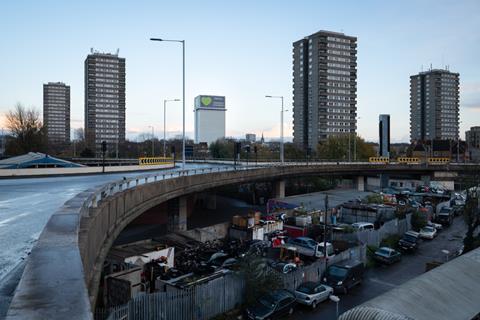The Grenfell Inquiry will present its conclusions next Wednesday more than seven years after the fire. Here’s a summary of the evidence the inquiry chairman Sir Martin Moore-Bick has had to unpick

It has been seven years, one month and 27 days since the UK construction industry was changed forever by the fire at Grenfell Tower. That tragedy, which claimed the lives of 72 people, was quickly recognised at the time as a watershed in how we design and construct tall buildings.
Since then, a new building safety regulator has been created, new rules rolled out to reduce the risk posed by fires, and the way the industry operates has been irreversibly changed. But we still do not know the definitive answer to the question: how did 3,000 sq m of highly combustible cladding panels end up being installed on a 24-storey residential tower?
On Wednesday we will finally get some answers in the form of the final report from the Grenfell Inquiry. Ordered the day after the 14 June 2017 blaze by then prime minister Theresa May, the inquiry has been split into two phases overseen by chairman Sir Martin Moore-Bick. The first, looking into the events on the night of the fire, was followed by a report published in 2019. The second phase, which will be the subject of next week’s report, assessed the causes of the disaster and the role of construction firms, product manufacturers and government policy.
>> See also: Grenfell Tower Inquiry’s final report to be published on 4 September
Much of the evidence heard during this phase has been shocking and is well known, but to remind readers of the key findings ahead of the report, here is a summary of what to look out for.
Government inaction
The inquiry heard evidence that the construction industry should take some, but by no means all, of the blame for the tower’s flawed refurbishment. Three elements contributed: sloppy design and construction work, misleading marketing of cladding products, and the government’s failure to recognise the risk of ACM.
Evidence from government officials and ministers highlighted how a policy of deregulation was adopted by the coalition government under David Cameron in the years before the fire which was intended to stimulate the economy in the wake of the 2008 financial crisis.
Further reading on the Grenfell Inquiry
>> Criminal trials for Grenfell Tower fire would not start until 2027, authorities say
>> Decay, delay and deregulation: what we have learnt from the Grenfell Inquiry
>> Grenfell Inquiry module two: A look back at key evidence about the cladding materials
>> A look back at Grenfell Inquiry module one: How experts blamed key players for ‘shambles’
>> Grenfell Inquiry explainer: How rival insulation firms covered up fire-safety data
>> One year on: What have we learned so far from Grenfell? Part one
>> One year on: What have we learned so far from Grenfell? Part two
In 2011, the Cabinet Office introduced a “one in, one out” policy which restricted departments to only adding new regulations if they removed existing ones. This was strengthened to “one in, two out”, in 2013 and “one in, three out” in 2016. This complicated the job of amending regulations as officials needed to balance any additions by choosing which rules they should cut.
At the time, officials were attempting to amend building regulations following the 2009 Lakanal House fire, which was caused by combustible cladding panels similar to the ones used on the later refurbishment of Grenfell Tower. These amendments were never made despite a series of warnings from worried industry experts, including several letters sent by the London Fire Brigade to the housing department in the months leading up to the fire.
Because of the government’s deregulation policy, relatively straightforward plans to clarify the risk of external fire spread in the wake of Lakanal had been expanded into a wider review of the entire 300-page Approved Document B, the part of building regulations that deals with fire safety. It was then expanded further to encompass a wider review of building regulations, a process which would take years.

Ministers claimed to have been “comforted” by officials in charge of the regulations that the situation was not “life safety critical” but there was also considerable confusion and miscommunication between those involved. Pickles, who led the housing department between 2010 and 2015, said he believed fire safety was exempt from the deregulation drive, yet officials were under the impression that it was not and had not spoken up because they considered it a “fight not worth having” in a policy environment where regulation was seen as a “dirty word”.
Brian Martin, the civil servant in charge of building regulations for nearly 18 years before the Grenfell fire, was also dealing with confusion in the industry over a term in the regulations which appeared to permit combustible cladding panels in high rise buildings. A passage under the heading “Insulation Materials/Products” stated that the tough fire standard of “limited combustibility” only applied to “filler” materials.
Despite the heading, Martin claimed at the inquiry that this also applied to the core of cladding panels such as ACM, the type used on Grenfell Tower. But he never clarified this before the fire, despite being warned of the confusion by a group of industry experts, telling the inquiry that he “probably forgot about it” as it had been a “busy time”.
Martin and other departmental officials were also aware of a disastrous fire test on ACM carried out in 2001. Despite receiving the Class 0 rating which permitted its use on tall buildings, the cladding product had burned with such ferocity that after just five minutes the flames reached 65ft high - twice the height of the test rig - and had to be extinguished due to safety concerns. Martin said the test had “just been forgotten”.
Despite this test, 16 years before Grenfell, and several widely reported cladding fires in the Middle East during that time, Martin told the inquiry that he had “completely underestimated the hazard” of ACM and had not raised the confusion over the word “filler” with any other senior official at the time.
Flawed product testing and marketing
Some of the above might suggest that the industry was defensibly acting within the regulatory environment before the fire. But a series of shocking disclosures from product manufacturers revealed how far some firms went to ensure cladding materials that they knew were unsafe could be sold on the market.
Hearings were told how Celotex, which manufactured most of the insulation installed behind the ACM panels, had rebranded the product after it had failed a fire test and then rigged a second test to ensure it would pass. Fire resistant boards had been surreptitiously added to the rig, apparently unnoticed by testing staff, to reduce the spread of flame.
A burn hall manager questioned by the inquiry said the reliance during tests was “very much on the honesty of the client” and that there was a “large element of trust in everything we do”. He denied being aware that Celotex had added the fire resistant boards, blaming the oversight on the burn hall being a “busy place”.

Celotex was said to have rigged the test after the firm’s owner Saint Gobain had given it a 15% profit increase target aiming to achieve a lucrative sale of the business. Jonathan Roper, a 23-year-old product manager who was given the job of developing the “new” product despite having no technical experience or training in building regulations, described Celotex’s actions as a “fraud on the market” and “completely unethical”.
Meanwhile, Arconic, which supplied the ACM panels that were found to be the primary cause of the fire at Grenfell Tower, had been selling the product using the test report from a different, less combustible version of the panels. When a fire test was conducted on the version used on Grenfell it failed “disastrously”, but this was never passed on to the British Board of Agrément (BBA), a certification body, which then issued certificates allowing the product to be used on high rise buildings. Arconic’s president denied that this had been “deliberate concealment”, insisting that the BBA “could have found out” about the failed test in an audit.
The inquiry also heard how Arconic had been selling the panels for 10 years despite being warned of the fire risks. A sales manager admitted in a secretly recorded phone call that the product had not been taken off the market because of “cost implications”.
>> See also: Kingspan, Celotex and Arconic settle civil claims with 900 people affected by Grenfell fire
Investigators had also found a small amount of Kingspan’s popular K15 insulation had been used in the cladding system for the refurbishment. In 2020, prior to the start of hearings, Kingspan had admitted that it had been marketing this product for 15 years using the test report of an older, chemically different version of the product. When the new variant had been tested in 2007, within 17 minutes it had turned the rig into a “raging inferno” which had to be extinguished over fears that it would set fire to the laboratory.
But despite the firm stating in its letter to the inquiry that it was “now of the view” that there were differences between the product that was tested and what had been sold on the market, a former technical project manager claimed this had been “common knowledge” at the firm since the product was altered.
Sloppy construction work
Adding to a confusing regulatory environment and misleading marketing of combustible cladding products was an array of shortcomings made by the project team which carried out the refurbishment.
Rydon was appointed main contractor by project client Kensington and Chelsea Tenant Management Organisation (KCTMO) in March 2014 on a £9.2m bid, the lowest out of four bidders. This came after a secret meeting that year between Rydon and KCTMO which had agreed to trim another £800,000 off the cost of the job.
The team, which included architect Studio E and facade engineer Harley, then set about choosing the products for the scheme. After considering zinc cladding, Arconic’s ACM panels were chosen in a value-engineering move to minimise costs and Celotex’s insulation panels were selected because of their thinness and “aspirational” thermal efficiency targets. The fire performance of the products was never properly scrutinised by any team members.

Harley was said to have lost technical expertise through staff changes and for a three year period did not employ anyone qualified to check the fire performance of specified materials. The firm had appointed the 25-year-old son of company boss Ray Bailey as project manager for the job after struggling to assemble a team. Expert witness Paul Hyett said the firm “clearly did not understand” the requirements of the ��ɫ����TV Regulations and produced “fundamentally flawed” detailed design work.
Hyett also said Rydon missed several “serious omissions and errors” in drawings produced by Studio E and its subcontractors, and had failed to establish a proper matrix of responsibilities between project team members. This became a crucial problem, allowing Studio E, which had no experience of working on high rise buildings, to shirk some its responsibilities, according to Hyett, who described the way in which the team supplied documents to building control as a “shambles”.
Rydon had also chosen not to hire fire consultant Exova as a full member of the project team. The firm, which continued to work on the scheme on ad ad hoc basis, has said it was excluded from the team.
This was rejected by another expert witness, Arup director Barbara Lane, who said Exova’s advice on fire safety had been “entirely inadequate”. The firm had said in a key document that the proposed works on the tower would have “no adverse effect” on external fire spread, despite having failed to analyse the designs or the cladding system.
Cavity barriers within the cladding system, designed to slow the spread of fire, were also found to have been either missing or so badly installed that they were ineffective. Two cladding fitters who had worked for Harley admitted to the inquiry that the quality of some of the firm’s work was “shocking” and “unacceptable”.


























No comments yet